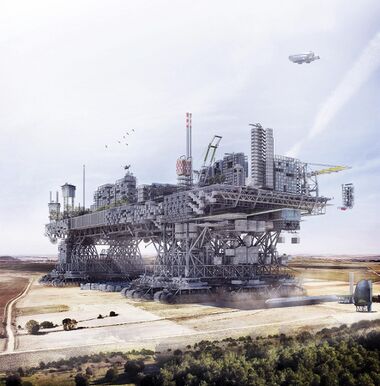Great Kavir Research and Sovereignty Patrol Structure
| This article is a stub. You can help IxWiki by expanding it. |
Script error: The module returned a nil value. It is supposed to return an export table.
| Great Kavir Research and Sovereignty Patrol Structure
(Burg: Estructure recherce e patroleuer soveiranetat della Gran Kavir (ERPSGK)) | |
|---|---|
 Great Kavir Research and Sovereignty Patrol Structure | |
| Dimensions | |
| Width | 410m |
The Great Kavir Research and Sovereignty Patrol Structure (Burg: Estructure recherce e patroleuer soveiranetat della Gran Kavir (ERPSGK)), colloquially known as the steel haboob, is a mega-land crawler/mobile research and territorial management base that is operated in the Great Kavir by Bulkh and Burgundie. It operates within the borders of Bulkh and is primarily used for mapping and research on the Great Kavir and for climate control efforts in the deep desert. It was constructed from 2017 through 2021 and has been in service since 2022.
Concept and development
The ERPSGK is based on the Crawler-transporters of the late 1960s, shipping gantry cranes. The plan was first proposed by an engineering student as an oil exploration vehicle in 1996, but it was not taken seriously as no private firm had the equity to construct such a vehicle and the oil reserves in the Great Kavir were assumed not to be enough to cover the cost of the vehicle. In 2009, the design was dusted off by the Army of Bulkh as a sovereignty patrol vehicle, but in a much smaller scale. The idea was again shelved as it was determined to be too expensive, and the use of aircraft and drones were sufficient for the threat level at the time. In 2012-2013 the increased and more overt use of the Great Kavir by Alainfisal as a throughfare for terrorists and drug running raised demands by the international community that Bulkh and Burgundie do something about the use of Bulkh's sovereign territory. Deployments of troops and increased overwatch had limited success due to the massive size of the Great Kavir, and only agitated Alainfisal who started a bombing campaign of the railroad running through the desert connecting northern and southern Bulkh. In 2013-2014 there were 17 bombings, 4 of them were to passenger trains killing 1,439 in total. The infrastructure required to develop a permanent base in the middle of the desert was determined to be unfeasible so once again the proposed mobile-city idea was raised. The structure would be used as a platform for helicopters, drones, ATVs, and light armored cars to interdict Alainfisal operatives, enforce territorial sovereignty, and could act as a place of refuge in the event of a train emergency.
The project was estimated at $8.3 billion and that it would take 3 years to build. To get the funding needed through the Constituent Council of Bulkh the army entered into a year of negotiations with other government agencies to try to come to a multi-agency compromise that could move forward as its own appropriations request, outside of their regular annual agency appropriations requests. They were able to get buy in from the National Academies of Science within the Ministry of Education, the Air Force, and Ministry of the Interior's Land Management Bureau, the Ministry of Justice's Bureau of Investigation and Enforcement, with a promise of a 25% match from Burgundie if the request was granted. The request was accepted in 2015, but it scaled down the proposed size from 560m in width to 410m, required that they have a Ministry of Interior's Nomadic Relations team onboard, and added a requirement that the stanchions that the treads were on be able to be raised high enough that they could clear the rail tracks without damaging them. They also stipulated that once Alainfisal was dealt with, the design had to be modular enough that this military hardware could be swapped out and scientific and climate management modules could be swapped in.
Over the next two years the Army worked with its partners to redesign the structure to meet their needs and the new legislative requirements. In 2017 the plan was formally greenlit, and construction started. 12 Crawler-transporters were bought from Urcea, Kiravia, and Caphiria and they were retrofitted to be compatible and use standardized parts. The 16 massive Hydrogen internal combustion engines were built by three different ship wrights in Bulkh. The structure was 58% recycled steel from the ship breaking yards of Tapakdore